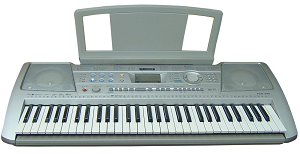A keyboard instrument is a musical instrument played using a keyboard. The most common of these is the piano. Some other types of keyboard instruments include celestas, which are struck idiophones operated by a keyboard, carillons, which are usually housed in bell towers or belfries of churches or other municipal buildings, and other non-acoustic instruments, such as various electronic organs, synthesizers, and keyboards designed to imitate other musical sounds.
Today, the term “keyboard” is most commonly used to refer to keyboard-style synthesizers. Under the fingers of a sensitive performer, the keyboard may also be used to control dynamics, phrasing, shading, articulation, and other elements of expression, depending on the design and inherent capabilities of the instrument.
Among the earliest keyboard instruments are the pipe organ, hurdy gurdy, clavichord and harpsichord. The organ is without doubt the oldest of these, appearing in the third century BC, though this early instrument, called hydraulis, did not use a keyboard in the modern sense. From its invention until the fourteenth century, the organ remained the only keyboard instrument. Often, the organ did not feature a keyboard at all, but rather buttons or large levers operated by a whole hand. Almost every keyboard until the fifteenth century had seven naturals to each octave.
The clavichord and the harpsichord appeared during the 14th century, the clavichord probably being the earlier. The harpsichord and the clavichord were both common until the widespread adoption of the piano in the 18th century, after which their popularity decreased. The piano was revolutionary because a pianist could vary the volume (or dynamics) of the sound by varying the vigor with which each key was struck. The piano’s full name is gravicèmbalo con piano e forte meaning harpsichord with soft and loud but can be shortened to piano-forte, which means soft-loud in Italian. In its current form, the piano is a product of the 20th century, and is far removed in both sound and appearance from the “pianos” known to Mozart, Haydn, and Beethoven. In fact, the modern piano is significantly different from even the 19th-century pianos used by Liszt, Chopin, and Brahms.
Keyboard instruments were further developed in the early twentieth century. Early electromechanical instruments, such as the Ondes Martenot, appeared early in the century. This was a very important contribution to the keyboard’s history.
Much effort has gone into creating an instrument that sounds like the piano but lacks its size and weight. The electric piano and electronic piano were early efforts that, while useful instruments in their own right, were not successful in convincingly reproducing the timbre of the piano. Electric and electronic organs were developed during the same period.
